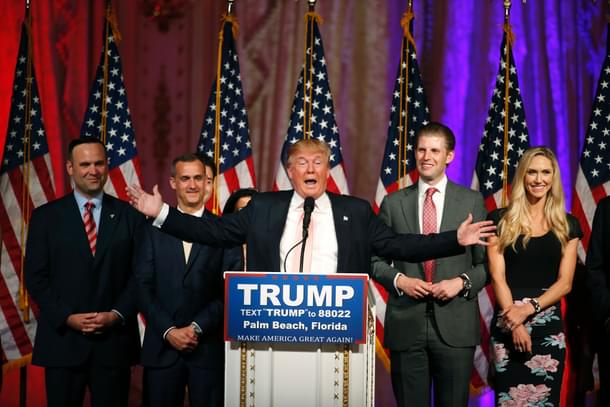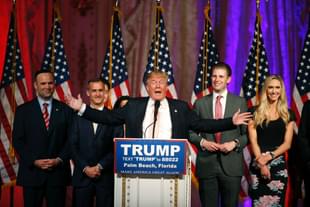Blogs
Trump: Maverick With A Method?
Sudarshan Khandige
Nov 15, 2016, 10:11 PM | Updated 10:11 PM IST
Save & read from anywhere!
Bookmark stories for easy access on any device or the Swarajya app.


‘Sorry Goose its time to buzz the tower” is a popular quote from the movie Top Gun, where the cult hero “Maverick” refuses to land the plane, defying his superiors orders. Its an apt description of US presidential elect, the maverick Donald Trump’s audacious and successful bid for the office of POTUS. Trump was conjectured to fail at the very outset. But behind all the bravado, braggadocio and bluster was he a merely a gambling maverick or was there a method to the seeming madness?
The realistic scenario of the last two decades is that the American dream had proven to be elusive to many people, unless they happened to be a techie on one of the coasts. Catering to and pampering the rich and maintaining the status quo had become the staple diet of the two main parties. Under the Democratic Party, ostensible a party of the working class, which held the presidency for a majority of the last two decades and also both houses of Congress for half a decade, trade unions had significantly weakened and so had the anti-trust enforcement. This resulted in wealthy mega corporations wielding political and economic power far beyond expected and the working class subsequently hammered. Its an understanding of this rather depressing backdrop that presented the perfect political opportunity to Trump.
The maverick Trump had to risk a departure from the traditional Republican Party narrative, carving out a unique and independent stand on vital issues. It’s now evident that from the very outset Trump was much more in sync with the pulse of the people, unlike the elitists of both the parties entrenched in their cozy bubbles.
Trump realized early on that the masses of the American hinterland had grown increasingly disconnected and disgusted with conventional, pro-establishment politics. Trump also knew that running as an outsider either as an independent or with one of the few other smaller parties was bound to fail, especially if he intended to make a determined, successful attempt for the presidency. He had after all previously run for president in 2000 as a Reform Party candidate, but the party nomination subsequently went to Pat Buchanan. Trump subsequently remarked that he felt the Reform Party was too dysfunctional to support his campaign and allow him to win. So a serious bid would have to be made from one of the two major parties.
In May 2015, Bernie Sanders, a two term independent senator from Vermont had announced his candidacy from the Democratic Party. Sanders had for a long time been strongly pro-labour and criticized the economic inequalities resulting from the elitist power structures of the two main parties. Trump himself announced his candidacy from the Republican party a month later. Trump had previously registered as a Republican in 2012.
On the primaries campaign trail, there was some surprising commonality between what Sanders and Trump said. Most importantly both were able to rouse people’s anger against the conventional power structures. Bernie himself drew huge crowds during his rallies and seemed very popular with the masses, especially among millenials, white and male voters. Some interesting analyses point to the fact that Bernie had beaten Hillary convincingly in the primaries in states like Indiana, Michigan, West Virginia and Wisconsin (a state which has never voted for a Republican president for the last 30 years). Trump subsequently won these states, helping significantly with his successful bid. A Bernie Sanders candidacy would have likely carried these states for the Democrats.
But Bernie was unable to successfully surmount the traditional power structures of the Democratic Party. Even the much needed modest radicalism that he represented and which people wanted were drowned in a flurry of “the coming dangers of socialism” paranoid missives. That the primary race was loaded against him from the beginning was evident from leaked emails and subsequent resignation of Debbie Wasserman Schultz, then chairperson of the DNC.
In the Republican Party, Trump found himself in the same situation as Bernie. His flashy, glamorous image was uncomfortable for Republicans flaunting conservative family values. Added to this his independent mercantilist views on trade and departure from the standard Republican notions on entitlement reform had alienated him from the Republican leadership. But unlike Bernie, he used his star power, publicity and combined it with an unwavering dogged defense of his politically incorrect ideas and gate crashed the primaries to emerge as the Republican candidate with a popular mandate.
Trump stunningly won the primaries while spending a fifth of Hillary ($65m vs $330m), even Bernie Sanders spent four times as much! Jeb Bush, Ted Cruz and Marco Rubio spent thrice as much before dropping out. The Republican Party was lucky in that the primary system allowed for choosing the truly popular candidate, something which failed the Democrats. Trump even prophetically tweeted in May 2016, that he would rather run against Hillary than Bernie and that was bound to happen as the system was rigged against Bernie.
On the presidential campaign trail the traditional Republican leadership unfortunately and conveniently did not stand by him. He ran his campaign with ruthless financial efficiency, in the end spending roughly half the money of Clinton, per electoral college vote. During the debates he stuck to the three main issues of trade, immigration and security. He also seemed to come across as more straightforward and blunt. He took a politically risky position by saying that countries like Germany, Japan and South Korea take greater care of their own defense, pay more for it themselves. He seemed wary of U.S’s increasingly detested role as global policeman and the associated costs therein. All unpopular and unconventional views, though the simple picture that emerged for the common man was that of a pragmatist whose main interest is in taking care of the country first.
An upside with Trump’s success is that he has broken the pervasive perception that a long standing record of previous public service is an absolute must have before running for public office successfully at the highest level. America after all is the land of the possible and the impossible, where out of the box, outrageous thinking is nurtured, encouraged and rewarded. So far this has been restricted to the tech world. It won’t be surprising to next see Bay Area tech moguls starting to actively consider this, especially if their phantasmic efforts to have California secede fail! A Ross Perot has attempted it previously, but by not doing it while being a part of either of the two main parties.
The American people always give a fair chance to a credible underdog, that is the essence of the country. Obama himself did it twice before. The sore losers, now protesting and rioting need to remember that Trump has won it fair and square.
Trump has been unequivocal in his support for India, Modi and even Hindus. Election rhetoric perhaps but he has not candy flossed it as typically done. It’s actually difficult to get top U.S. politicians to even pay lip service to India-pertinent issues. A genuine Trump-Modi partnership could be vital in controlling and freeing South Asia of its security worries, also stop Pakistan from being the global hub of terror.
The popular myth doing the rounds is that the last time the Republicans controlled the Senate, House and Congress was in 1928 and the great depression followed. Fact is that they controlled all three both under Eisenhower and George W Bush. Its also true that under Eisenhower they went to war in Korea and again in Iraq under Bush. They again control all three and doomsday is supposedly on the horizon again. But it’s now to be seen if the Republicans can prove the critics wrong. Trump the maverick with a method has demonstrated right intent. If he can now plan, walk the talk and execute it will be a great victory for the American people and the global community.
Sudarshan Khandige is a technologist and a contrarian. Sees the world as a mosaic rather than a mono-culture. Bangalore and Bay Area





